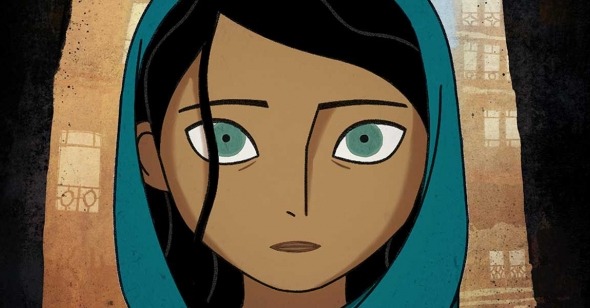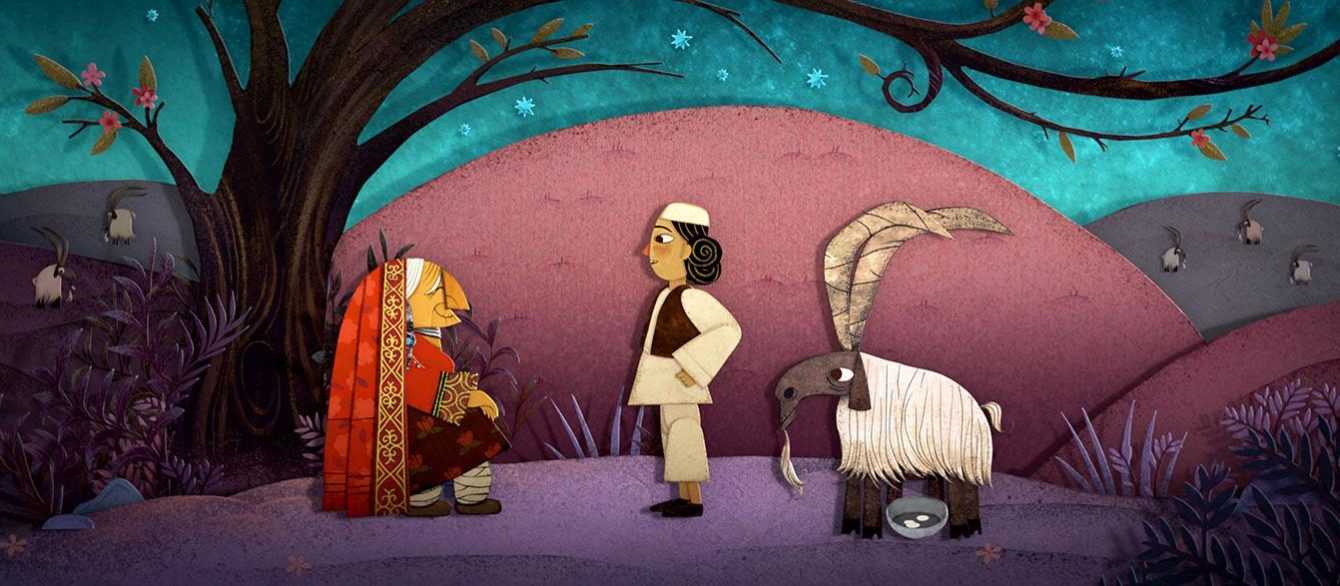


Interlochen Center for the Arts
The entire film is pretty similar to The Breadwinner overall. They both have heavy themes of government oppression, particularly towards women, and both feature stories where a woman is the center focus. I liked this a lot as it showcased the harsh reality that many women face in oppressive countries like Iran.
One specific scene that immediately reminded me of the breadwinner was when Marjane’s mother stood up against a man insulting her on the street. He told her to put her scarf down more and she responded by addressing him angrily and demanding respect. He called her names but she and Marjane got in their car and left before things got worse, which was a display of power both the women had before the oppression in Iran got too bad. To me this seemed extremely similar to the kind of power the women had in The Breadwinner when Parwana’s father was present. He, being the head of the household, acted as a sort of cover if the family got into hot water. Until being sent to prison, the family was content with this setup and, as this was all they could do, they had to cope with the reality that they needed a man to do certain things for them.
Both settings oppress women by making them cover their bodies or it’s considered a “sin”.
I think both movies can tell us a lot about how people can survive under such smothering government rule. Sometimes if it’s all you know you think it’s normal, and you come to another country and realize it’s not and you have to try to fit in with people you don’t know. I also just overall think it’s a great way to learn about these sorts of things through complex storytelling and really compelling character. I found both to be very interesting and I definitely feel like there are a lot of nuances I may have missed by only watching them one time through.
In Persepolis, there’s a tense scene where Marjane is stopped by the morality police for wearing sneakers, a denim jacket with a “punk is not ded” printed on the back, and a headscarf that isn’t “proper” enough. Though her outfit may seem harmless, under Iran’s strict regime however, it is seen as a threat to social order. The officers accuse her of dressing like a punk, how it’s too Western and that she’s tempting men with her appearance, which reinforces the idea that women are responsible for maintaining “morality.” She realizes that she’s in great danger since women have been arrested, beaten , or even killed for breaking dress codes, even for something as simple as sneakers. Marjane does eventually manage to escape, but in moments like this shows the suffocating control the government has over women. Similarly, in The Breadwinner, Parvenu faces an even harsher reality under Taliban rule, where women cannot leave home without a male escort, which is crazy. And to survive, she cuts her hair and disguises herself as a boy, allowing her to move freely and provide for her family. Unlike Marjane, who faces oppression but still has some freedom for rebellion, Parvana’s situation is even more dire, since her only option for survival is to literally erase her identity entirely.
Both scenes show the way repressive regimes control women’s bodies, choices, and freedoms. Marjane and Parvana, though in different countries and circumstances, are both forced to navigate societies in constant fear and uncertainty. Whether it’s the morality police enforcing dress codes or the Taliban banning women from public spaces, the message is that the same-woman’s autonomy is dangerous.
The women and families in Persepolis and The Breadwinner cope with oppression differently, but do often overlap in ways. Examples in Persepolis, despite knowing the dangers, Marjane’s parents secretly listen to banned Western music, host underground parties, and support or even encourage their daughter to think critically, even if it means putting their lives on the line. They refuse to fully conform, even as they publicly obey the rules. And likewise, Parvana’s family, especially her mother, refuse to accept the Taliban’s restrictions, attempting to seek help from an official despite the danger. Another character is Shauzia, like Parvena, copes by transforming herself into a boy, but unlike Parvenu, who remains deeply tied to her family, Shauzia dreams of leaving Afghanistan entirely, leaving everything behind. She constantly talks about running away to France, where she imagines herself living by the sea. In a world that constantly limits her, holding onto this vision allows her to mentally escape.
The Breadwinner and Persepolis have a strong themes of storytelling and education. Both Marjane and Parvana have fathers that seek to educate them of their countries past. Their fathers want them to see their country to be more than the war stricken present.
In both films, Marjane and Parvana have to grow up under oppressive regimes, although they both react differently. Marjane’s parents do a very good job of teaching her the realities of the Shah’s regime but she is too young to understand the pain until her uncle Anoosh gets executed. She idolizes Che Guevara and Karl Marx like they were figures in a fairy tale. not to say that she is childish, just to say her parents did a good job of protecting her and letting her be a kid. However, in Parvana’s case she doesn’t get as much protection. Her father does his best to educate her and tell her stories, but he couldn’t shelter her from the taliban. even when she cuts her hair and assumes the identity of atesh the freedom of appearing like a boy does not protect her from the horrors of war.
Where the two movies differ is in their endings. Marjane is able to escape the war into europe but at the cost of feeling like an outsider so she returns. although we never get to see if Parvana escapes the war with her family, she overcomes a lot and fights for her father’s return. even though parvana never gets to escape to europe its interesting to think about what she would think of it. She and Shauzia dream of a future unburdened by the war that they fight every day. would they like it? if Parvana was the one who went to europe to study, would she encounter the same difficulties of fitting in? I think she would. people find it hard to understand experiences they have not lived through. I can read all i want about what war and oppression is like, but i will never understand what it feels like.

The Breadwinner (2017) and Persepolis (2007) are both animated films that focus on young female protagonists navigating war-torn and politically oppressive environments. Both of the films follow these protagonists (Parvana in The Breadwinner, and Marjane in Persepolis) as they navigate their lives through the oppression, war and societal restrictions (Afghanistan under Taliban rule in The Breadwinner and Iran during and after the Islamic Revolution in Persepolis).

Parvana disguises herself as a boy to support her family under Taliban rule, while Marjane questions and rebels against the restrictions placed on her in post-revolutionary Iran. The Breadwinner uses a mix of hand-drawn animation and stylized storybook sequences, emphasizing folklore and resilience. This is most evident in the scenes where Parvana is telling stories, where a very flat picture-book style is used, and a very similar scene is used in Persepolis, where Marjane’s father is telling a story to her.
The stories stylistically look similar, almost looking like cut-out paper puppets, however where The Breadwinner uses this frame narrative to tell a fictional story, Persepolis uses this frame narrative to tell a true historical story. (about the father of the Shah and how the current government came to be.) Besides the fact that one is in black and white and the other is in color, it is also true that the puppet like characters seemed to be more endearing in The Breadwinner as opposed to Persepolis, partly because in the first mentioned film, you are supposed to be rooting for the character rather than angry at them. However, both are still seen from the child’s point of view.
Sadly, I couldn’t find an Image for the scene that I am talking about in Persepolis- but I found it for The Breadwinner!

Both films tell powerful stories of young girls coming of age in oppressive environments, but The Breadwinner leans more into the struggle for survival and resilience, while Persepolis provides a more reflective and autobiographical take on rebellion, and identity. Their different animation styles and tones serve their narratives well, making them compelling yet distinct in their impact.
https://www.google.com/url?sa=i&url=https%3A%2F%2Fwww.okcmoa.com%2Fvisit%2Fevents%2Fthe-breadwinner%2F&psig=AOvVaw1aIKUBfP06egHQJyBMzawg&ust=1741729954929000&source=images&cd=vfe&opi=89978449&ved=0CBcQjhxqFwoTCODymuy_gIwDFQAAAAAdAAAAABBK
https://www.google.com/url?sa=i&url=https%3A%2F%2Fwww.nytimes.com%2F2017%2F11%2F16%2Fmovies%2Fthe-breadwinner-review.html&psig=AOvVaw1aIKUBfP06egHQJyBMzawg&ust=1741729954929000&source=images&cd=vfe&opi=89978449&ved=0CBcQjhxqFwoTCODymuy_gIwDFQAAAAAdAAAAABBa
https://www.google.com/url?sa=i&url=https%3A%2F%2Fwww.nytimes.com%2F2007%2F12%2F25%2Fmovies%2F25pers.html&psig=AOvVaw03-G8aac74Oe5xZZhKzZSQ&ust=1741731179890000&source=images&cd=vfe&opi=89978449&ved=0CBcQjhxqFwoTCIDeyrfEgIwDFQAAAAAdAAAAABAJ
https://www.google.com/url?sa=i&url=https%3A%2F%2Fen.wikipedia.org%2Fwiki%2FPersepolis_%2528film%2529&psig=AOvVaw03-G8aac74Oe5xZZhKzZSQ&ust=1741731179890000&source=images&cd=vfe&opi=89978449&ved=0CBQQjRxqFwoTCIDeyrfEgIwDFQAAAAAdAAAAABAR
© 2025 Animation World History
Theme by Anders Noren — Up ↑